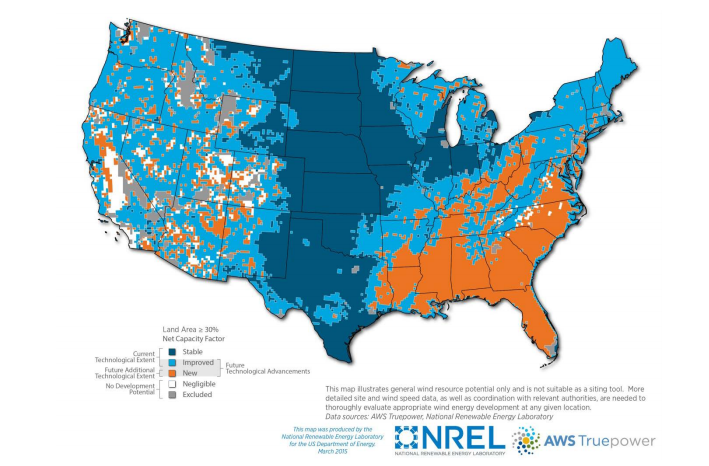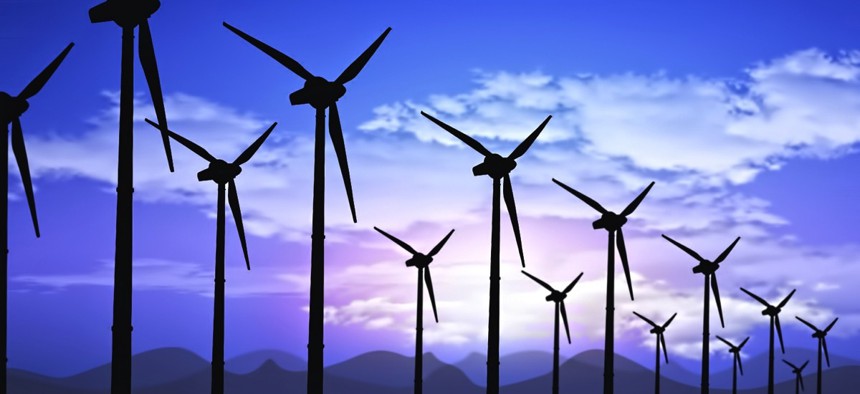Connecting state and local government leaders
A new Department of Energy report suggests that new technology could unlock renewable energy potential in Southeastern states. But building new wind farms will likely involve a mix of practical and political challenges.
Compared to gustier locales in other parts of the country, strong winds don’t blow consistently across much of the Southeastern United States, which is one of the main reasons wind energy developers have avoided the region.
But new technology could help change that.
A report released last week by the U.S. Department of Energy shows that taller wind turbines could unlock new opportunities for wind power in the Southeast and other areas not known to be blustery. Wind energy production in the U.S. has climbed steeply over the last decade, and currently provides nearly 5 percent of the nation’s generated electricity.
The Department of Energy report considers a scenario where wind power would meet 10 percent of U.S. electricity demand by 2020 and 20 percent by 2030.
To reach that 20 percent threshold in 2030, the reports says that “installations will need to include low wind speed sites such as the southeastern United States.” A map in the report highlights the future potential for wind facilities in places where they do not currently exist on a commercial scale, including states such as Alabama, Florida and Georgia.
But building these new wind farms will likely involve a mix of practical and political challenges. The bigger turbines create new logistical complications, and at least one set of proposed projects, in Alabama, faced stiff local opposition before the developer canceled it last year.
Even so, wind energy proponents see the information in the Department of Energy report as promising.

“Looking back just five or 10 years ago a lot of people just had the mindset that there isn’t really a resource in the Southeast,” said Jen Banks, director of operations for the Southeastern Wind Coalition, a nonprofit focused on wind energy development in the region. “It’s really with these technological advancements that we’ve got more areas opening up to economically viable, or potentially economically viable wind energy.”
“It’s something that developers will be looking at,” Banks added.
A key technological advancement is engineering that allows for the taller wind turbines. The current maximum height for turbines in the U.S. tends to be around 80 meters, measured to the “hub” at the center of the blades. That’s 262 feet, roughly the same height as a 24-story building.
But according to the Department of Energy, in the coming years it could be feasible to build turbines as high as 140 meters, or about 459 feet. Factoring in the length of the blades, a turbine this size would be over 700 feet tall, about half the height of the Empire State Building.
The taller turbines are beneficial because they can capture higher velocity winds that occur further away from the ground, increasing the potential for energy production.
The Department of Energy report points out that 110-meter turbines are already being used in European countries, including Germany.
Georgia Power, a utility that provides electricity in the Peach State, will add enough new wind power to its grid beginning in 2016. Enough, the utility says, to power about 50,000 homes. But that energy will be brought to Georgia across state lines, from the Blue Canyon Wind Farm in southwestern Oklahoma.
As of early 2015, there were no major wind power facilities operating in Georgia, according to the American Wind Energy Association. From Georgia Power’s perspective, whether taller wind turbines will lead to new development remains unclear.
“We’re aware of these new studies, but we’re not sure what that means in terms of does it become feasible yet,” said John Kraft, a spokesman for the utility.
“There’s just not that much wind,” he added.
The average wind speed across most of Georgia tends to be under 5.5 meters per second, at a height of 80 meters, according to estimates prepared by AWS Truepower Inc., a company that provides renewable energy consulting. That same figure in parts of Texas, the nation’s top wind-producing state, was around 10 meters per second, or about 22.4 miles per hour.
Despite the gentler air currents that tend to prevail in the Southeast, the Wind Coalition's Banks noted that there are a number of proposed projects in North Carolina.
There has also been increasing attention on the potential for offshore wind generation in Southern states. But information the Department of Energy published in March does not project offshore wind production to grow significantly in the region until after 2020.
And despite technological progress, issues beyond wind speed promise to create obstacles for new development. For example, the report notes the difficulties of transporting parts for taller wind turbines, some of which might not fit under highway bridges. There are also questions about windmills interfering with aircraft, degrading the performance of radar systems, and harming wildlife.
State and local governance and politics also comes into play.
Last summer, a Texas-based wind company, Pioneer Green Energy, called off a project that would have involved building between 37 and 53 wind turbines across two sites in Alabama.
In canceling the project the company cited state regulations for wind turbines, which they said were too strict.
Residents in two Alabama counties where the wind farms were planned had also filed lawsuits in an effort to stop the facilities from being built. Some of their claims said the turbines would drive down property values, create noise pollution and mar the local landscape.
While not referring specifically to the situation in Alabama, Banks pointed to the lack of wind projects currently located in the Southeast as one possible reason that the facilities might encounter skepticism or pushback.
“It’s more difficult sometimes because it’s new, and anything that’s new creates more concerns, and more questions for people,” she said.
Banks added that if wind farms come online in North Carolina, or in other Southeastern states, that might begin to assuage these types of worries. “That’s just going to help the industry move forward,” she said, “once there’s a project close by that people can take a look at.”

NEXT STORY: Cybersecurity Risk or Building Block for More Open Government?




